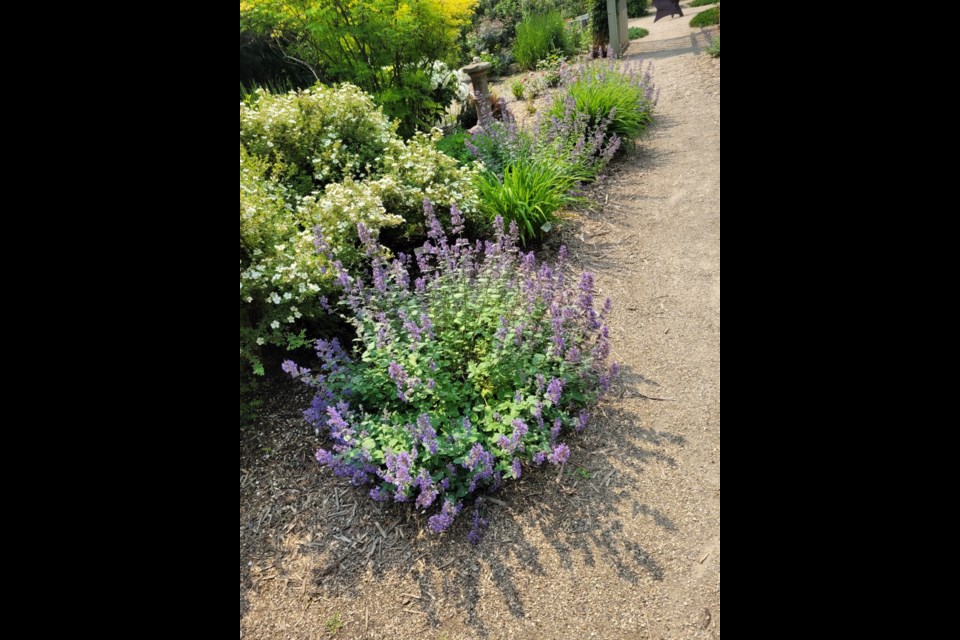Gardeners are seldom neutral when it comes to catmints. Like cats, they generally love them or hate them. Catmint aficionados enjoy their long bloom period, attractive foliage, and easy association with other plants – both flowers and foliage “work” in terms of colour, texture and scale, as well as “weaving” diverse border plants together. Catmint haters target the invasiveness of a few species, as well as the perversity of neighbourhood cats attracted to these plants.
Cats may be attracted to the aromatic oil within catmint, nepetalactone, that is released when the foliage is crushed. Closely related to feline sexual pheromones, it causes cats to be silly. The effects last for a few minutes, but cats may return frequently, ultimately decimating the plants. An individual cat’s response to catmint is both genetic and hereditary. Australian cats, coming from a relatively small gene pool limited by strict quarantine regulations, are generally indifferent to catmint. Nor are young kittens or older cats affected by it. My theory, somewhat biased and without scientific support: city cats go for it as they’re somewhat bored. Country cats have better things to do with their time and more options and generally leave it alone.
A member of the mint family (Labiatae), perennial catmints (Nepeta) are characterized by four-sided stems and opposite leaves. The oblong to heart-shaped foliage is aromatic and an attractive blue- or grey-green. The small, tubular, two-lipped flowers in blue, purple, white or cream, are arranged in whorls on long racemes. Catmints are floriferous and bloom over a long period of six to eight weeks. They attract bees and butterflies for nectar but are resistant to deer and rabbits.
They’re hardy, easy to grow, and flourish in full sun and well-drained soil. Insect and disease-free, they’re remarkably drought-tolerant once established. Shearing to about 25 centimetres above ground level after blooming is optional. The more invasive catmints work well as groundcovers where irrigation is not available.
Here are some selections, beginning with the most compact and well-behaved:
‘Dropmore Blue’ (30 x 45 cm/12 x 18 in.), introduced by the late Dr. Frank Skinner of Manitoba in 1932, is my favourite. It has large, bright blue flowers for almost eight weeks, attractive blue-green foliage, and is well-behaved and non-invasive. Because the flowers are sterile, there are no unwanted seedlings. Top that off with 小蓝视频 hardy, drought-tolerant and problem-free. It’s useful in rock gardens, perennial or mixed borders and for edging rose or shrub beds. It’s also very effective in bordering gravel or flagstone paths and is used in the Forestry Farm Park gardens in Saskatoon in this manner.
‘Walker’s Low’, the 2007 Perennial Plant of the Year, is named for the Irish garden where it was found, not its height. It easily reaches a height and spread of 90 cm (3 ft.), making it a plant for the mid-border. It has a long blooming period in mid-summer, blue-violet flowers and attractive grey-green foliage.
'Junior Walker', a seedling of 'Walker's Low,' is non-seeding and smaller (25 x 40 cm). The blue-green foliage compliments the lavender-blue flowers which bloom for most of the summer.
‘Six Hills Giant’ (1 x 1.3 m/3 x 4 ft.) has lavender-blue flowers and lovely grey foliage. It’s excellent for mass plantings. A sterile hybrid, it flowers prolifically but produces no seedlings. The long racemes are good as cut flowers.
‘Cat’s Pajamas’ (Nepeta hybrid) is a dwarf variety with brilliant indigo-blue flowers along the entire length of the stems. Rose-purple calyxes extend the colour past peak bloom. It’s suitable for small spaces, containers or as edging along pathways, borders and beds.
‘Cat’s Meow’ (Nepeta faassenii) produces rich lavender-blue flowers on upright flop-proof stems, with a dense, uniform habit. Plants grow into a broad spreading mound, making this a good choice for mass plantings, containers and border edging.
Nepeta sibirica (syn. Dracocephalum sibiricum), native to Siberia and China as the name suggests, forms a large upright plant of 90 cm and tends to be invasive. This makes it a poor choice for an average urban yard but excellent for a larger rural landscape that can’t be irrigated but is crying out for a bright splash of summer blue. It grows well by my rural mailbox and in my pasture garden where it is seen and admired from a great distance. ‘Blue Beauty’ (syn. ‘Souvenir d’ Andre Chaudron’) has served me well for almost three decades.
This column is provided courtesy of the Saskatchewan Perennial Society (SPS; [email protected]). Check our website () or Facebook page () for a list of upcoming gardening events.




